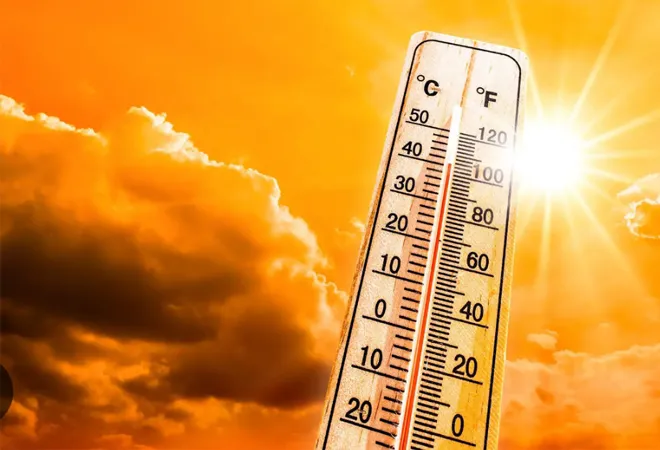Dr. Seema Javed
Extreme temperatures above 40°C that impacted billions of people across Asia in April were made hotter and more likely by human-caused climate change, according to an analysis by an international team of leading climate scientists from the World Weather Attribution group. The study highlights how heatwaves intensified by climate change are making life much tougher for people living in poverty across Asia and the 1.7 million displaced Palestinians in Gaza. Asia was hit by severe heatwaves this April.
In South and Southeast Asia, Myanmar, Laos, Vietnam broke records for their hottest April day, and the Philippines experienced its hottest night ever. In India, temperatures reached as high as 46ºC. The heat was also extreme in West Asia, with Palestine and Israel experiencing temperatures above 40°C. The month was the hottest April on record globally and the eleventh consecutive month in a row a hottest month record was broken. Heat-related deaths were widely reported, with at least 28 in Bangladesh, five in India and three in Gaza during April, while surges in heat deaths have also been reported in Thailand and the Philippines this year. These are only preliminary figures and because heat-related deaths are notoriously underreported, it is likely there were hundreds or possibly thousands of other heat-related deaths in Asia during April.

The heat also led to crop failure, loss of livestock, water shortages, mass die-off of fish, widespread school closures, and the heat has been linked to low voter turn-out in Kerala, India. Climate change, caused by burning oil, coal and gas, and other human activities like deforestation, is making heatwaves more frequent, longer and hotter around the world. To quantify the effect of human-caused warming on the extreme temperatures across Asia, scientists analysed weather data and climate models using peer-reviewed methods to compare how these types of events have changed between today’s climate, with approximately 1.2°C of global warming, and the cooler pre-industrial climate. The analysis focused on the periods when the heat was most dangerous in two regions: the three-day average of maximum daily temperatures in a region of West Asia that included Syria, Lebanon, Israel, Palestine and Jordan, and the 15-day average of maximum daily temperatures in the Philippines.
The scientists also analysed the possible influence of the El Niño–Southern Oscillation, a naturally occurring climate phenomenon that shifts between El Niño, neutral and La Niña conditions The study also analysed historical weather data for a region of South Asia that includes India, Bangladesh, Myanmar, Laos, Vietnam, Thailand and Cambodia. The researchers did not carry out a full attribution analysis for this region as the World Weather Attribution has conducted similar studies in 2022 and 2023, and the data from weather observations showed that the attribution results would not be significantly different.
In West Asia, the scientists found that April heatwaves with temperatures above 40°C are more frequent due to warming caused by human activities. In today’s climate, with 1.2°C of warming, similar heatwaves are expected to occur about once every 10 years. Climate change made the heat about five times more likely and 1.7°C hotter. In the future, extreme temperatures in West Asia could become even more frequent and intense. If warming reaches 2°C, as they are expected to in the 2040s or 2050s unless emissions are rapidly halted, similar heatwaves will occur about once every five years and will become another 1°C hotter.
El Niño does not have an influence on the high temperatures in West Asia. In the Philippines, similar heatwaves are expected to occur about once every 10 years during El Niño conditions and about once every 20 years in other years without the influence of El Niño. Without human-induced climate change, such an event would have been virtually impossible, even under El Niño conditions, the scientists found. Overall, climate change made this year’s heatwave 1°C hotter, while El Niño made the heatwave a further 0.2°C hotter. If global warming reaches 2°C, similar heatwaves in the Philippines will occur every two to three years and will become another 0.7°C hotter.
Finally, in South Asia, similar 30-day heatwaves can be expected to occur about once every 30 years. However, they have already become about 45 times more likely and 0.85°C hotter due to climate change, according to historical weather data. This result is consistent with World Weather Attribution’s previous studies in the region that found climate change made April heatwaves about 1°C hotter and 10-30 times more likely. The analysis of historical weather data also found that similar heatwaves are twice as likely to occur during El Niño conditions.
The study highlights how climate change is making life much tougher for people in Asia living in poverty and dealing with the effects of war. In Gaza, many of the 1.7 million displaced people are living in improvised tents that trap heat, have limited access to healthcare and clean drinking water, and lack options to stay cool. Across South and Southeast Asia, the hundreds of millions of people who live in informal housing and work outdoors, like farmers, construction workers and street vendors are disproportionately affected by extreme heat. While high temperatures are the norm across Asia during April, the increasing risk of dangerous heat, particularly in rapidly growing cities, such as Manila, highlights the critical need for heat planning that protects vulnerable groups, the researchers say. Countries across Asia such as India have made substantial progress on developing heat action plans.
However, across the continent, there are still significant gaps in planning for dangerous heat. The study was conducted by 13 researchers as part of the World Weather Attribution group, including scientists from universities and meteorological agencies in Malaysia, Sweden, the Netherlands, and the United Kingdom. Quotes Mariam Zachariah, Researcher at the Grantham Institute – Climate Change and the Environment, Imperial College London, said: “Climate change is bringing more days with potentially deadly temperatures to Asia every year. “This result is unsurprising, but important for highlighting the dangers of extreme heat in Asia. “Unless the world takes massive, unprecedented steps to reduce emissions and keep warming to 1.5°C, extreme heat will lead to even greater suffering in Asia.”
Friederike Otto, Senior Lecturer in Climate Science at Grantham Institute – Climate Change and the Environment, Imperial College London, said: “From Gaza to Delhi to Manila, people suffered and died when April temperatures soared in Asia. “Heatwaves have always happened. But the additional heat, driven by emissions from oil, gas and coal, is resulting in death for many people.
“If humans continue to burn fossil fuels, the climate will continue to warm, and vulnerable people will continue to die.” Carolina Pereira Marghidan, Climate Risk Consultant at the Red Cross Red Crescent Climate Centre, and PhD researcher at the Royal Netherlands Meteorological Institute said: “The threat of extreme heat is rapidly increasing across Asia. More than four billion people live on the continent, with heat impacting the most vulnerable groups disproportionately. “Heat-related impacts on health are not well-monitored or documented. This really hampers our ability to understand the true impacts and full spectrum of risks associated with extreme heat. “Heat action plans set out measures for dealing with heat, like changing work and school hours. Although various countries have made substantial progress on such plans, there is an urgent need to scale up and further strengthen them across Asia to deal with the rising heat.” Notes World Weather Attribution is an international collaboration that analyses and communicates the possible influence of climate change on extreme weather events, such as storms, extreme rainfall, heatwaves, and droughts. The group has completed more than 70 studies on a range of extreme weather events around the world using peer-reviewed methods.
The Intergovernmental Panel on Climate Change included research by World Weather Attribution to provide evidence that human-caused climate change is already intensifying weather extremes in every region of the world in its Sixth Assessment Report published in March, 2023.
 Jubilee Post News & Views
Jubilee Post News & Views





